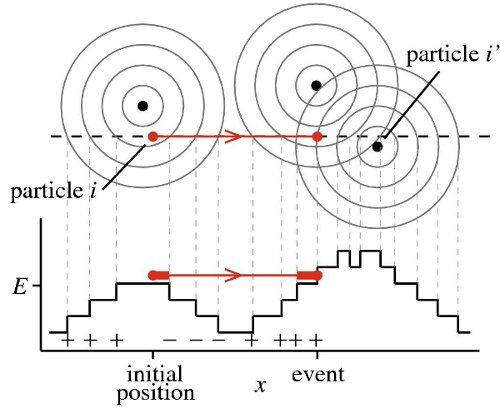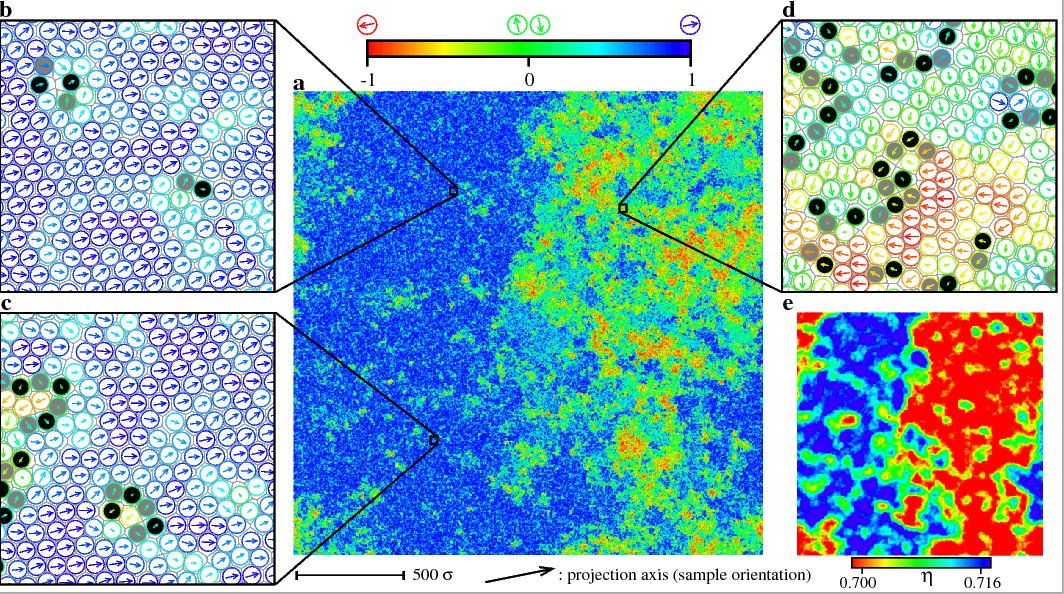Main Page
From Werner KRAUTH
| Revision as of 13:17, 11 December 2011 Werner (Talk | contribs) (→Event-driven Monte Carlo algorithm for general potentials) ← Previous diff |
Revision as of 13:19, 11 December 2011 Werner (Talk | contribs) (→A picture book of algorithms) Next diff → |
||
| Line 39: | Line 39: | ||
| [[Image:Boson trap fast.gif|100px|right|frame|Direct-sampling algorithm for ideal bosons in a trap (see [[Holzmann Krauth 1999|article with M. Holzmann]]). Adapted for interacting bosons, this algorithm was used in a variety of articles.]] | [[Image:Boson trap fast.gif|100px|right|frame|Direct-sampling algorithm for ideal bosons in a trap (see [[Holzmann Krauth 1999|article with M. Holzmann]]). Adapted for interacting bosons, this algorithm was used in a variety of articles.]] | ||
| - | [[Image:Event chain movie small.gif|100px|left|frame|Event-chain Monte Carlo algorithm for hard spheres and related systems (see [[Bernard Krauth Wilson 2009|article with E. P. Bernard and D. B. Wilson, including Python implementation]]). This (fantastic) algorithm, about two orders of magnitude faster than local Monte Carlo, was used in our [[Bernard Krauth 2011|discovery of the first-order liquid-hexatic phase transition in hard disks]].]] | + | [[Image:Event chain movie small.gif|100px|left|frame|Event-chain Monte Carlo algorithm for hard spheres and related systems (see [[Bernard Krauth Wilson 2009|article with E. P. Bernard and D. B. Wilson, including Python implementation]]). This (fantastic) algorithm, about two orders of magnitude faster than local Monte Carlo, was used in our [[Bernard Krauth 2011|discovery of the first-order liquid-hexatic phase transition in hard disks]]. The method can be generalized to [[Bernard_Krauth_b_2011|continuous potentials.]] |
Revision as of 13:19, 11 December 2011
Welcome to my new webpage (construction area)
Contents |
Upcoming events
Summerschool: First Les Houches school in computational physics: soft matter June 20, 2011 - July 1, 2011, Les Houches, France
Workshop: PyPhy - Python in Physics 2011, August 29, 2011, ENS, Paris
Satellite meeting of the 4th European Meeting of Python in Science (Euroscipy 2011) also taking place at August 25-28, 2011, ENS, Paris
Current research
I am deeply interested in statistical physics and condensed matter physics, often in connection to computation and algorithms. Current interests are in hard spheres, mainly the melting transition in two-dimensional disks, bosons (in collaboration with the experimental groups at ENS), and the theory of convergence and of coupling in Markov chains. Practically all my work is in collaboration with colleagues and students.
Event-driven Monte Carlo algorithm for general potentials
In recent works, as for example on the melting transition in two dimensions, the event-chain algorithm has proven quite helpful. This hard-sphere Monte Carlo method runs a lot faster than earlier methods although the speed-uo remains constant for large system sizes. Nevertheless, gaining a factor of about 100 is not so bad for run-times (with the new algorithm) on the order of a few months... we got our results before it was time to retire.
Recently, Etienne Bernard (now at MIT) and I were able to extend the event-chain algorithm to continuous potentials, and we are now quite excited: The algorithm allows to break detailed balance, it is (hopefully) much faster than local Monte Carlo algorithms, and it is extremely easy to program, to parallelize (hopefully), to modify and, why not, to improve. Technically, we work with stepped potentials (see the figure, similar approaches exist for molecular dynamics), but there is no problem going to finer and finer discretizations: the algorithm doesn't even slow down as we crank up the number of steps. But lots of things need to be done to understand this new approach, to check out possible applications, etc, and we are right now extremely busy.
Two-dimensional melting: First-order liquid-hexatic transition
Here, I show the key figure of a recent paper, with Etienne Bernard, on the melting transition in hard disks. The main picture shows the orientations of a configuration with 1024x1024 disks, and two different regions are clearly visible: To the left, disks have more or less the same orientation, whereas to the right, the orientations vary (and the local densities are lower). To produce the picture, we used theevent-chain algorithm, a new Monte Carlo method that we developed a few years ago, with David Wilson. This algorithm is really the first one to outperform the classic Metropolis method from 1953. For a long time, I have been interested in the hard-disk melting problem, but an earlier attempt to speed up the extremely slow converge of numerical methods for this problem, the cluster algorithm that I developed with C. Dress, had failed.
Text book

A picture book of algorithms

[[Image:Event chain movie small.gif|100px|left|frame|Event-chain Monte Carlo algorithm for hard spheres and related systems (see article with E. P. Bernard and D. B. Wilson, including Python implementation). This (fantastic) algorithm, about two orders of magnitude faster than local Monte Carlo, was used in our discovery of the first-order liquid-hexatic phase transition in hard disks. The method can be generalized to continuous potentials.
[[image:Exact_diag.jpg|100px|center|frame|Exact diagonalization algorithm for Dynamical mean field theory (see article with M. Caffarel). This algorithm has been instrumental in our discovery of a first-order Mott transition in the Hubbard model in infinite dimensions. Much of our early work in the field is written up in our review with Georges, Kotliar, and Rozenberg]]

Research areas
Address
Werner Krauth Laboratoire de Physique Statistique École normale supérieure 24 rue Lhomond 75231 Paris Cedex 05 France Tel +33 (0) 44 32 25 50



